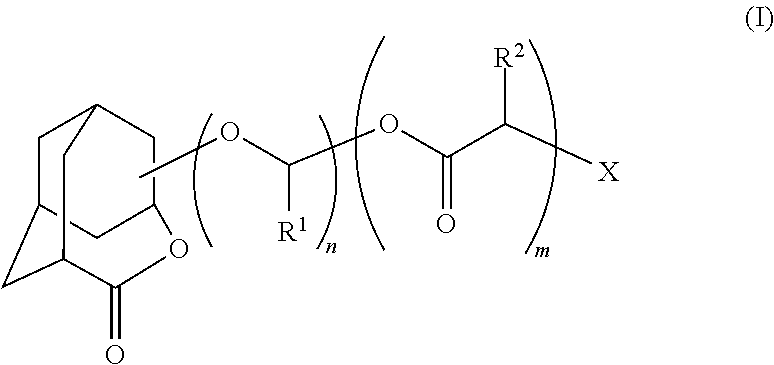Homoadamantane derivative, method for producing the same and photosensitive materials for photoresist
a technology of homoadamantane and derivative, applied in the direction of photosensitive materials, instruments, photomechanical apparatus, etc., can solve the problems of not being able to meet the required performance, not being able to achieve pattern accuracy which is sufficient to correspond to a decrease in size, and not being able to achieve the required performan
- Summary
- Abstract
- Description
- Claims
- Application Information
AI Technical Summary
Benefits of technology
Problems solved by technology
Method used
Image
Examples
example 1
[0135]Synthesis of Homoadamantane Derivative: (5-oxo-4-oxa-5-homoadamantane-1-yl)oxymethylchloride
[0136]In a 1L-flask, 54.7 g (300 mmol) of 5-oxo-4-oxa-5-homoadamantane-1-ol, 400 mL (5.6 mol) of dimethylsulfoxide (DMSO) and 200 mL (2.1 mol) of acetic anhydride were added, followed by stirring for 3 days. Then, the resultant was subjected to gas chromatography analysis. As a result, it could be confirmed that 5-oxo-4-oxa-5-homoadamantane-1-ol was completely converted to methylthiomethyl ether.
[0137]To this reaction mixture liquid, 150 mL of water and 300 mL of diethyl ether were added, and the resultant was shaken and allowed to stand. Thereafter, an aqueous phase and an organic phase were separated. 150 mL of diethyl ether was added again to the aqueous phase, and the resultant was shaken and allowed to stand. Thereafter, an aqueous phase and an organic phase were separated. This procedure was further repeated twice, and the organic phase was dried with magnesium sulfate. The result...
example 2
[0141]Synthesis of a Homoadamantane Derivative: (5-oxo-4-oxa-5-homoadamantane-2-yl)oxymethylchloride
[0142]A stirring device was attached to a 1L-separable flask provided with a nozzle for introducing hydrogen chloride gas. To this flask, 54.7 g (300 mmol) of 5-oxo-4-oxa-5-homoadamantane-2-ol, 13.6 g (450 mmol) of paraformaldehyde, 36.2 g (300 mmol) of magnesium sulfate and 650 mL of dried dichloromethane were added, and the resultant was cooled on ice bath to 0° C. and stirred. To this flask, a hydrogen chloride gas generated by mixing 292 g (5.0 mmol) of sodium chloride and 700 mL of concentrated sulfuric acid was blown through the nozzle for 1 hour. Further, after stirring for 3 hours, magnesium sulfate was filtered, and gas chromatography analysis was conducted. As a result, it was confirmed that 5-oxo-4-oxa-5-homoadamantane-2-ol was completely converted into an ether.
[0143]Hydrogen chloride and dichlorometane were removed by distillation, whereby 58.1 g (251 mmol, isolation yiel...
example 3
[0147]Synthesis of a Homoadamantane Derivative: 2-(5-oxo-4-oxa-5-homoadamantane-1-yl)oxy-2-oxoethylchloride
[0148]In a 1L-flask, 36.4 g (200 mmol) of 5-oxo-4-oxa-5-homoadamantane-1-ol was added, and dissolved in 200 mL of tetrahydrofuran. To the resulting mixture, 41.8 mL (300 mmol) of triethylamine was added. While cooling the flask on ice bath, 19.1 mL (240 mmol) of chloroacetyl chloride was slowly added dropwise for about 30 minutes.
[0149]Thereafter, stirring was conducted for 3 hours. Then, 100 mL of water was added to terminate the reaction. The resulting reaction mixture was extracted with diethyl ether, washed with water, and dried with anhydrous sodium sulfate. After filtration and concentration, purification was conducted by re-crystallization, whereby 39.8g (154 mmol, isolation yield: 76.9%, GC purity: 97.9%) of intended 2-(5-oxo-4-oxa-5-homoadamantane-1-yl)oxy-2-oxoethylchloride represented by the following formula was isolated. Each data of GC-MS, 1H-NMR and 13C-NMR are s...
PUM
| Property | Measurement | Unit |
|---|---|---|
| stroke width | aaaaa | aaaaa |
| temperature | aaaaa | aaaaa |
| temperature | aaaaa | aaaaa |
Abstract
Description
Claims
Application Information
 Login to View More
Login to View More - R&D
- Intellectual Property
- Life Sciences
- Materials
- Tech Scout
- Unparalleled Data Quality
- Higher Quality Content
- 60% Fewer Hallucinations
Browse by: Latest US Patents, China's latest patents, Technical Efficacy Thesaurus, Application Domain, Technology Topic, Popular Technical Reports.
© 2025 PatSnap. All rights reserved.Legal|Privacy policy|Modern Slavery Act Transparency Statement|Sitemap|About US| Contact US: help@patsnap.com



